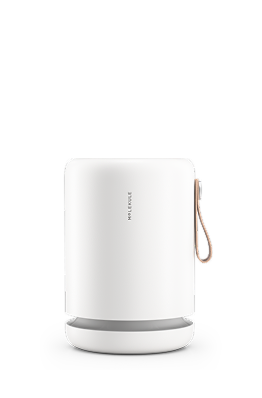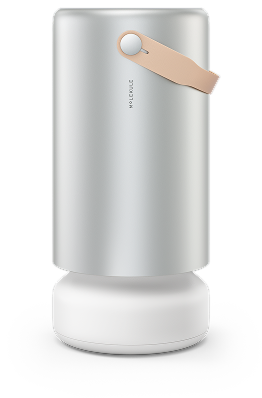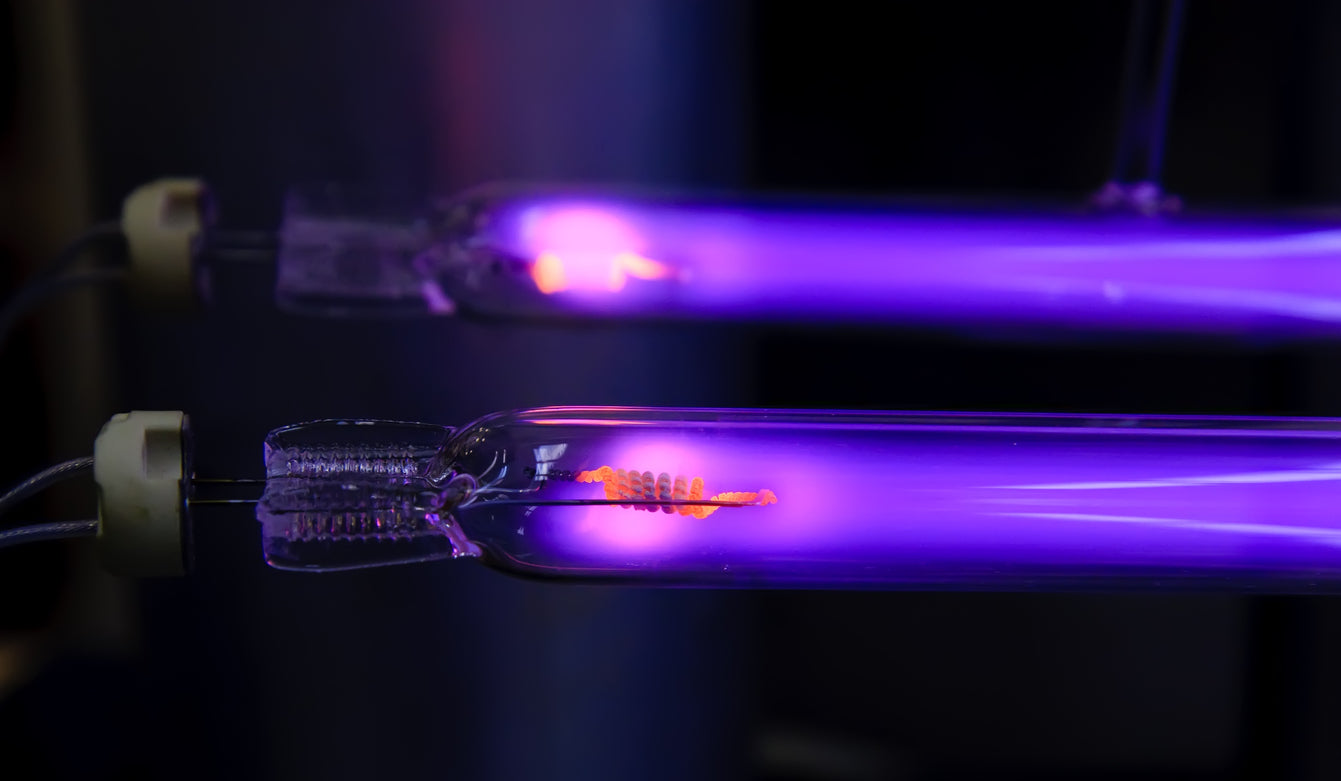The way that UV light is used in an air purifier, and the type of UV light that is used, is different when it comes to air purifiers. Here is how the Molekule PECO technology uses UV light, and what that means for cleaning the air in your home. If you’re wondering if using a UV light can reduce the chances of coronavirus infection, check out our blog on what to know about how UV light kills Covid-19.
The type of UV light matters
UV light is invisible to the human eye, but is responsible for not-so-invisible problems like sunburn, premature aging of the skin, and cancer. For the most part, the ozone layer in the atmosphere protects us from the most damaging levels of UV from the sun. But here on earth we have developed technology that produces UV light for a variety of purposes, including the PECO technology used in Molekule devices for air purification.
There are three different “colors” or bands of UV light: UV-A, UV-B, and UV-C. Each has different properties and reacts with living things in different ways. The important thing to note is the byproducts that are created when using each type, because that is what comes into play when an air purifier uses UV light.
- UV-A light: Also known as “black light,” UV-A light is not absorbed by the ozone layer. This is the same type of UV light often used to make decorations glow fluorescently. While the least damaging of the three bands, UV-A light can still damage the eyes by causing cataracts over time and can also age the skin prematurely when you are exposed to it outside. When used in an air purifier, no byproducts are created while using UV-A light.
- UV-B light: UV-B light has a shorter wavelength than UV-A and is partially absorbed by the ozone layer. It is thought to be mostly responsible for sunburn by causing direct DNA damage and also a risk of cancer. UV-B can also harm the eyes by causing a swelling of the cornea. However, a little exposure to UV-B is necessary to produce vitamin D and to promote the creation of the vital neurotransmitter serotonin. The WHO suggests 5 to 15 minutes of sunlight a few times a week while clothed to keep your vitamin D levels high.
- UV-C light: UV-C light carries the most energy of the three bands, and is particularly dangerous when it comes to bodily exposure, causing sunburn, DNA damage, eye damage, and eventually cancer. Fortunately the ozone layer absorbs almost all of the UV-C that comes from the sun. UV-C is the only band of UV light that is absorbed by oxygen, converting it to ozone. This means that UV-C light is both stopped by the ozone layer and the cause of it. When air purifiers use UV-C light, ozone is potentially created as a byproduct.
How Molekule PECO technology uses UV light
Molekule’s PECO technology uses only the UV-A band to initiate a catalytic process, and does not actively use it to directly clean the air. The UV LEDs used in PECO imparts energy to a nanocatalyst to power an oxidative chemical reaction. The UV-A light itself does not affect pollutants in the air because it is a relatively weak form of UV—the light is only used to drive the chemical reaction on the surface of the nanocatalyst.
What is the blue light at the top of the Molekule device?
Though a blue light is emitted from the top of a Molekule unit, this is not UV light, which is invisible. It is actually the catalyst glowing fluorescently like a poster in the presence of the “black light” from the UV-A LEDs inside.
How other air purifiers use UV light technology
PECO isn’t the only air purification technology that uses UV, but it’s the only one that uses UV-A. Many manufacturers have found uses for UV-C. For instance, since it is capable of affecting the vital molecule of life, DNA, UV-C is very useful in sterilizing microbes.
Microbes are very tiny, as their name suggests, and tend to be single-celled. If their single cells absorb enough UV-C to damage their DNA, microbes don’t get cancer, but they become incapable of reproducing.
UV Germicidal Irradiation (UVGI)
Air purification system manufacturers have found a few different ways to use UV-C. The most common method is called UV Germicidal Irradiation, or UVGI. This is commonly employed in the healthcare industry to sterilize biohazardous equipment, or to slow the formation of mold in HVAC ducts. Since microbes hiding in a shadowed area or covered by dust wouldn’t be sterilized, UV systems designed to achieve this are usually paired with another method of microbial inactivation. Therefore it is important to ensure that the design of the UVGI system allows for sufficient time in front of the light because different microbes are sterilized at different rates.
Another common method is to design a UV-C light source to shine on a HEPA filter. HEPA filters are not antimicrobial, so adding a UV-C light can potentially sterilize these organisms after they are captured. However, excessive dust or other light-blocking matter can absorb the UV and protect any microbes.
Moreover, with any UV air purification device, a sufficient dwell time in front of the light source is important for complete sterilization and destruction. Merely blowing past a UV bulb for a few seconds may not be sufficient to sterilize many different microbes.
Photocatalytic Oxidation (PCO) air purifiers
There are a few air purification solutions that take a similar route as PECO to clean the air. These products are most often referred to as photocatalytic oxidizers (PCO) or by the name of their catalyst, usually titanium dioxide (TiO2). Similar to PECO, these systems are designed to utilize the energy from UV-C to power a chemical reaction that oxidizes pollutants in the air. But they are different from PECO in that they can generate ozone as a byproduct and also must be precisely configured to maximize the efficiency with which pollutants are processed. Insufficient efficiency in this regard can lead to incomplete oxidation byproducts, including formaldehyde and acetic acid, which can be toxic.
The production of toxic ozone is always a concern with any device that uses UV-C light. Some manufacturers design their air purifiers to pass treated air through a sheet of activated carbon after UV-C treatment or use special quartz bulbs to reduce ozone production. If you are seeking to acquire a device that uses UV-C, be sure it is certified to not produce dangerous levels of ozone.
How the effectiveness of PECO compares to other UV products
- Allergens: PECO’s fabric filter halts the flow of allergen-bearing particles where they can then be subjected to oxidation by the UV-A-fueled nanocatalyst (as opposed to UV-C, which is not known to have any impact on allergens in the air). Unlike UV-C air purifiers that are designed to inactivate pollutants, PECO technology destroys allergens like mold, pet dander and pollen.
- VOCs: While UV-C can affect VOCs, it is not clear if this is a result of the ozone generated or from actual destruction of the compounds. There also hasn’t been any conclusive research showing UV-C can handle VOCs. But in laboratory testing, PECO was able to destroy VOCs in the air.
- Microbes: Given a sufficient dwell time in front of the source of UV-C, airborne microorganisms such as mold spores, bacteria, and viruses can be sterilized. However for complete destruction of all toxins inherent in microbes it’s unclear if UVGI alone is sufficient. Halting microbes on the surface of a PECO-Filter is a way to subject them to a sufficient concentration of reactive oxygen species to oxidize them into trace gases.
- Solid particles: UV-C alone has no practical effect on non-living particles like dust, but PECO is capable of halting particles and collecting them in its fibers.
Molekule (PECO) vs. UV light air purifiers: How it’s different
The Molekule PECO technology has been designed to power its catalytic reaction with UV-A specifically because UV-A is a safe, yet efficient, type of light that does not produce ozone. Unlike Molekule, which uses UV-A light, other air purifiers use UV-C light specifically, either to directly sterilize microbes or, if used in combination with a PCO stage, to eliminate other organic airborne toxins as well. UV-C light carries a number of issues with utilizing this more dangerous type of light, primarily because it produces ozone as a byproduct. From an effectiveness standpoint, it is unclear to what extent UV-C light air purifiers can clean the air.
To summarize, Molekule air purifiers are very different from other air purifiers that use UV light—both from a technological standpoint of how it cleans the air, as well as its efficiency in destroying pollutants. To learn more about the results of PECO on pollutants, see our article: “Third-Party Confirms Molekule Air Purifier Destroys VOCs” and our public reports.







